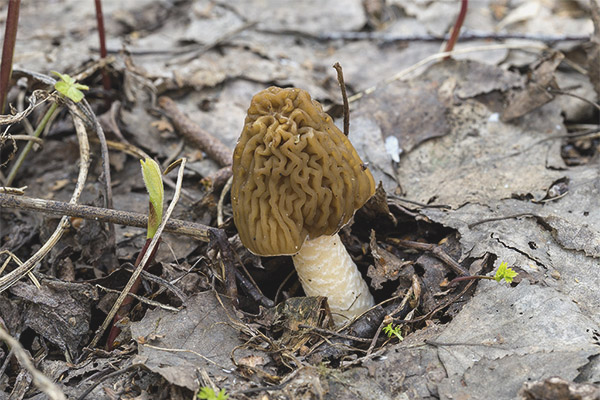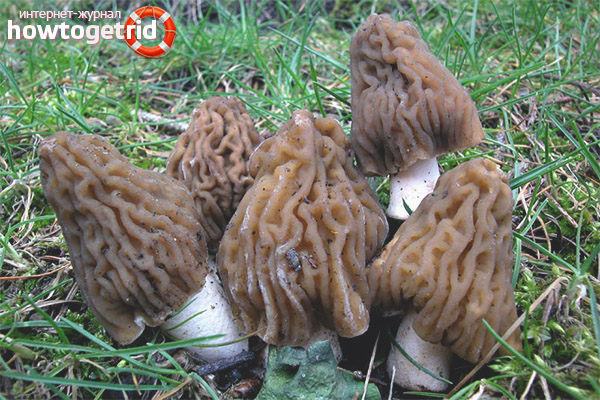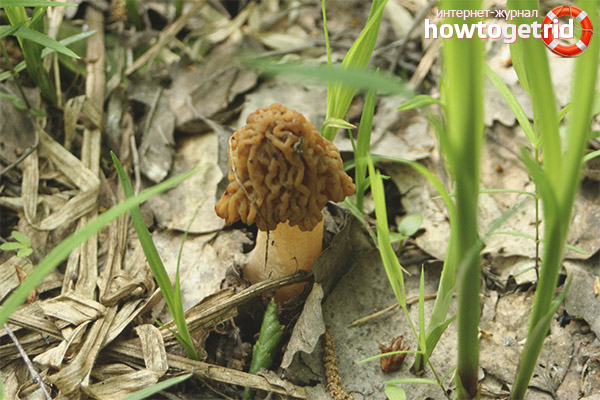The content of the article
Already in spring some species of mushrooms appear in the forest. For example, in a deciduous forest in which a lot of aspen grows, in the period after the rain you can usually see a morel hat. This type of mushroom is also called a cap or delicate morel. But you can not always see them, as they tend to disappear after a short period of time.
This species belongs to the family Morel. In appearance, they look like morels. Their hat has a bell shape. It looks like it’s just wearing a hat. That is why the view is called.
Appearance
The cap has a wrinkled surface. Its size can be from 2 to 6 cm in height, and the width is 1-4.5 cm. The color of the cap varies with age. The young fungus, they have a dark brown shade. But in an adult he is brighter, becomes yellow or ocher.It grows together with the leg only at the top, and in the lower part its surface is smooth and has streaks.
The leg is curved. Its length can be up to 14 cm. But most of the mushrooms have a stem 5-10 cm long. It is cylindrical in shape, but sometimes flattened. Its thickness is 2-3 cm. Old mushroom has hollow legs. The young morel hats in the leg has a pulp, which by its consistency resembles cotton wool, and has a yellowish color.
Among the fungi, such species as morel and conic also belong to the morel species. They are conditionally edible.
Where grows
Representatives of this species are growing in the Northern Hemisphere. They prefer conditions of a temperate climate, high humidity. You can meet in the forest in the middle or at the end of spring. He likes to have water nearby.
In places with ideal conditions, they grow in large groups of up to 75-80 pieces. As a rule, you can see them around aspens and birches. Sometimes near linden.Most of these mushrooms can be seen in the old aspen. The soil is sour.
Edibility and composition
Experts consider this type of mushroom conditionally edible. Therefore, before cooking, it is necessary to cook it for about 15 minutes. It is important that at the same time in the tank was a lot of water, which is then drained. After such a simple treatment, the morel cap becomes softer and gets a pleasant taste. After that, the mushroom can be cooked at will. It is suitable for both salting and frying. If you dry them in cream, the taste is excellent. So they were prepared in the old days.
Consume them and dried. The toxins that are in the composition will disintegrate in a month. In its raw form can not be consumed. In ancient times in Russia, various tinctures were prepared from this mushroom, which helped to cure eye diseases.
These mushrooms are very low-calorie. They contain 92% water. About 3 g of protein and less than a percentage of fat and carbohydrates. In addition, they have dietary fiber.
Similar species
Since the cap of the representatives of this species is attached to the stem only at the top, it is quite simple to distinguish this mushroom from the others.There are similar toxic storch mushrooms, in which the cap and leg are well connected. These mono mushrooms are more commonly found near the coniferous tree. And their flesh is more dense.
Since these species are very similar to honey by themselves, they both are considered conditionally edible. That is, they must be boiled before cooking. It is important to remember that the toadsin hiromitrin will not completely disappear from morels. To the toxin out of the pulp completely, the fungus is dried for at least six months. It can also be dried at high temperature.
How to cook
After the morel cap mushrooms have undergone appropriate heat treatment, they are allowed to be cooked in any way suitable for the mushrooms.
They are excellent pickled, salted or fried. Often used as a filling for pies, added to the soup, any sauce. They perfectly complement the taste of potatoes. Often, a morel hat is used as a separate dish.
Raw specimens must be well dried. You can add them in soups only in a month. They can be crushed to sprinkle them with various dishes. They will give any of them a great aroma and taste.Experienced mushroom pickers dry these mushrooms in order to use them in the winter. To cook a morel cap, the same recipes are used as for cooking an ordinary morel.
Before cooking, they must be soaked in water, after adding a little salt to it. This will help clean them of dirt and various debris. After that they are thoroughly washed. In order to boil 1 kg of mushrooms of this type, you need to add 15 g of salt to the water, a few bay leaves, and also about 30 pieces of black peppercorns.
Mushrooms are boiled together with all these ingredients and in plenty of water for at least 15 minutes. This decoction can not be eaten in any case, it is poured.
Sometimes they are used for salting. To do this, 1 kg smoked hats need 50 g of salt. From spices you can put dried dill, cloves. You can also add currant leaves. First, they are boiled in the manner described above, the water is drained. And then boil with the addition of salt and spices for 20 minutes. Cook until they sink to the bottom. Then they are placed in the bank. But they need to be stored in a cool place, and it will be possible to use them only in 2 months.
This mushroom has a very good taste.You just need to know how to distinguish it from storchkov - and you can safely collect. But it is very important to follow all the rules of cooking, so as not to harm their health. Dishes of these mushrooms, you will surely delight all their households. But small children are better not to give them.
Video: morel hat - where and when to look for this mushroom?













To send